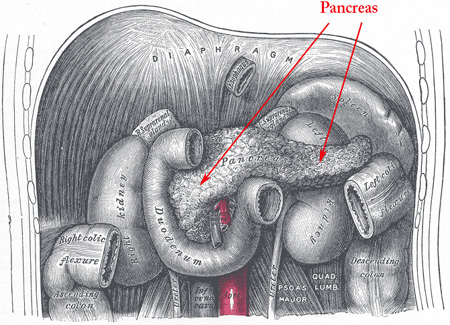Pancreas

Pancreas
The normal adult pancreas has a dual function and composition - the exocrine component that produces enzymes necessary for digestion of food and the endocrine component, necessary for insulin production and regulation of blood glucose levels. The exocrine component is composed of lobular units of acini, that discharge their secretions into progressively larger ducts that finally merge into the main pancreatic duct - the duct of Wirsung and the accessory pancreatic duct of Santorini. The duct of Wirsung ends at the major duodenal papilla (papilla Vateri) and the duct of Santorini ends at a minor duodenal papilla.
The pyramidal-shaped acinar cells are large with their apical areas filled by markedly eosinophilic zymogen granules and the basal cytoplasm is deeply basophilic. The acinar cells at the central portion of the acinus (centroacinar cells) fuse with the intercalated duct that fuses with the acinus. The intercalated ducts combine to form the intralobular ducts, which are lined by small cuboidal cells with pale cytoplasm. The intralobular ducts combine to form the interlobular ducts that are lined by mucin-secreting, tall columnar epithelium. The ducts of Wirsung and Santorini are lined by similar columnar epithelium with a greater proportion of goblet cells.
The Langerhans islets, which constitute 1-2% of the cell mass in the adult pancreas, represent the endocrine component of the pancreas. These islets comprise a greater proportion of the pancreas at the time of birth. The islets are round, compact structures that are highly vascularised with sparse connective tissue. The diameter of islets is highly variable with an average of approximately 225µm. The main cell types in the islets are beta cells - responsible for insulin production, alpha cells - responsible for glucagon secretion, delta cells - responsible for somatostatin secretion and PP cells - the pancreatic polypeptide secreting cells.
Cancer: Pancreatic cancer
|